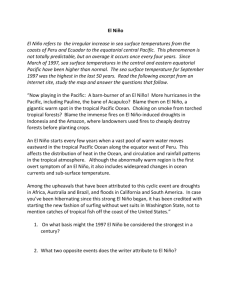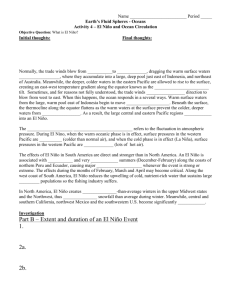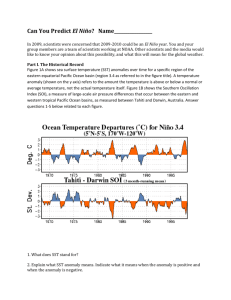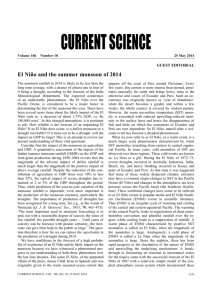El Niño appears to be developing rapidly Gary Robbins, science
advertisement
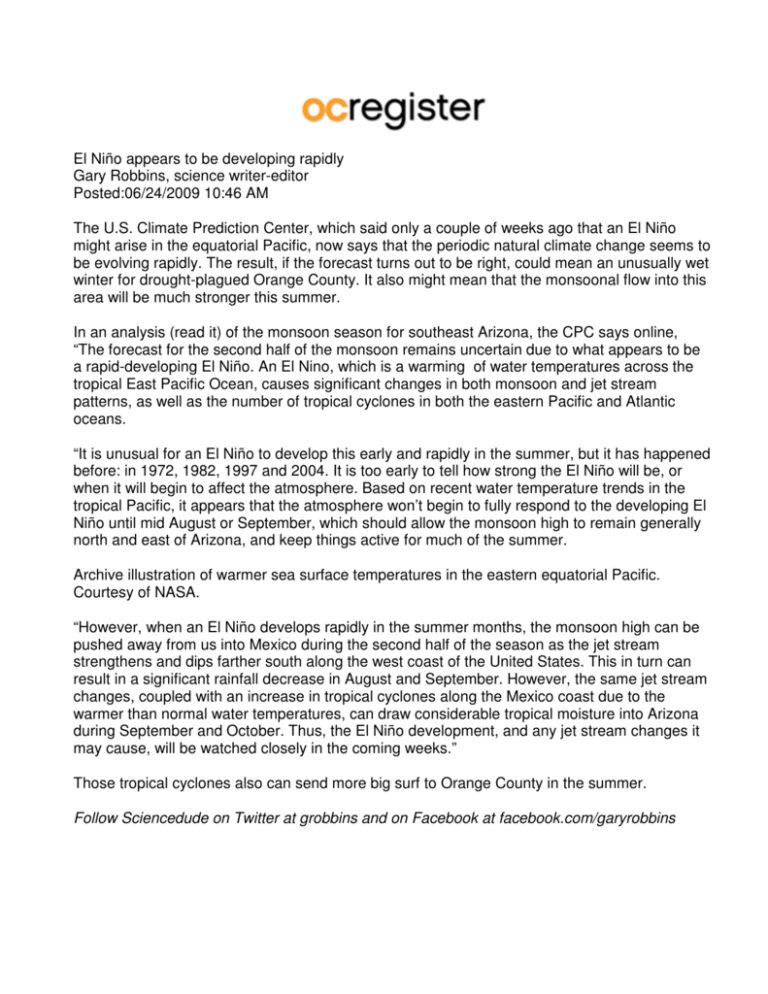
El Niño appears to be developing rapidly Gary Robbins, science writer-editor Posted:06/24/2009 10:46 AM The U.S. Climate Prediction Center, which said only a couple of weeks ago that an El Niño might arise in the equatorial Pacific, now says that the periodic natural climate change seems to be evolving rapidly. The result, if the forecast turns out to be right, could mean an unusually wet winter for drought-plagued Orange County. It also might mean that the monsoonal flow into this area will be much stronger this summer. In an analysis (read it) of the monsoon season for southeast Arizona, the CPC says online, “The forecast for the second half of the monsoon remains uncertain due to what appears to be a rapid-developing El Niño. An El Nino, which is a warming of water temperatures across the tropical East Pacific Ocean, causes significant changes in both monsoon and jet stream patterns, as well as the number of tropical cyclones in both the eastern Pacific and Atlantic oceans. “It is unusual for an El Niño to develop this early and rapidly in the summer, but it has happened before: in 1972, 1982, 1997 and 2004. It is too early to tell how strong the El Niño will be, or when it will begin to affect the atmosphere. Based on recent water temperature trends in the tropical Pacific, it appears that the atmosphere won’t begin to fully respond to the developing El Niño until mid August or September, which should allow the monsoon high to remain generally north and east of Arizona, and keep things active for much of the summer. Archive illustration of warmer sea surface temperatures in the eastern equatorial Pacific. Courtesy of NASA. “However, when an El Niño develops rapidly in the summer months, the monsoon high can be pushed away from us into Mexico during the second half of the season as the jet stream strengthens and dips farther south along the west coast of the United States. This in turn can result in a significant rainfall decrease in August and September. However, the same jet stream changes, coupled with an increase in tropical cyclones along the Mexico coast due to the warmer than normal water temperatures, can draw considerable tropical moisture into Arizona during September and October. Thus, the El Niño development, and any jet stream changes it may cause, will be watched closely in the coming weeks.” Those tropical cyclones also can send more big surf to Orange County in the summer. Follow Sciencedude on Twitter at grobbins and on Facebook at facebook.com/garyrobbins Local News El Nino to affect O.C. through early 2010 Posted:07/12/2009 6:54 AM EL Nino causes sea surface temperatures to rise in the eastern equatorial Pacific, adding punch to winter storms in Southern California. Image courtesy of NOAA It’s official: The natural, periodic climate change known as El Nino has developed in the Pacific Ocean and is expected to affect the weather in Orange County and the rest of Southern California throughout the coming winter, says the National Oceanographic and Atmospheric Administration (NOAA). The likely impact is above average rainfall in a region that’s recorded below average precipitation each of the past three years. The county is officially listed in severe drought by federal forecasters. (Full NOAA forecast.) “NOAA expects this El Niño to continue developing during the next several months, with further strengthening possible. The event is expected to last through winter 2009-10 …” the agency says in a news release. (Full statement.) “El Niño’s negative impacts have included damaging winter storms in California and increased storminess across the southern United States. Some past El Niño’s have also produced severe flooding and mudslides in Central and South America, and drought in Indonesia. “An El Niño event may significantly diminish ocean productivity off the west coast by limiting weather patterns that cause upwelling, or nutrient circulation in the ocean. These nutrients are the foundation of a vibrant marine food web and could negatively impact food sources for several types of birds, fish and marine mammals.” El Nino also can warm the ocean to the point where hurricanes that develop off Mexico track unusually far to the north-northwest, sending big waves to Orange County. Follow Sciencedude on Twitter at grobbins and on Facebook at facebook.com/garyrobbins • • • • • • • 4.0 earthquake off San Diego lightly shakes southern Orange County Newly discovered tremors on San Andreas might suggest large quakes to come Airborne radar to monitor O.C. earthquake threats Animation of 3.9 seafloor earthquake hitting O.C. View NASA animated flyover of O.C., LA counties Interview with Mercury astronaut Scott Carpenter NEW: Astronauts photograph O.C., Southern California from space station Post from: Sciencedude

